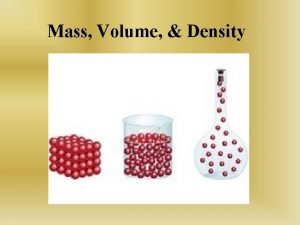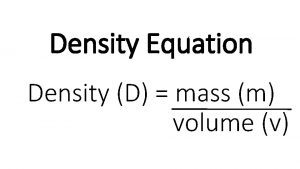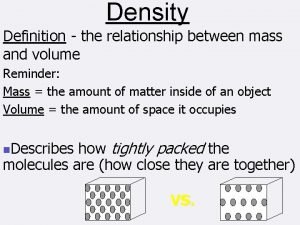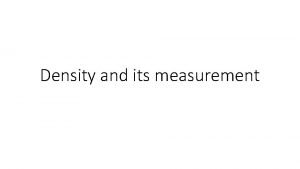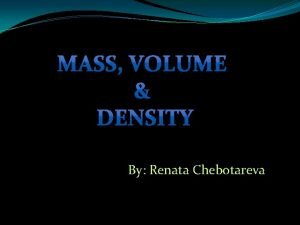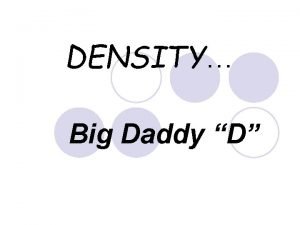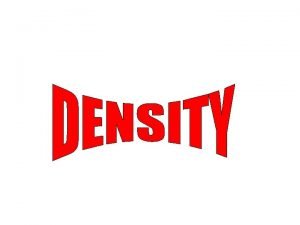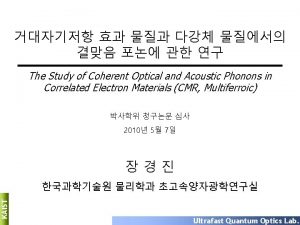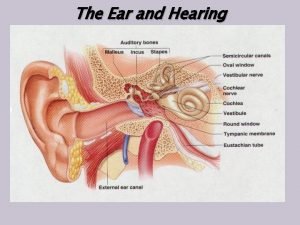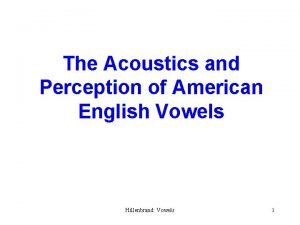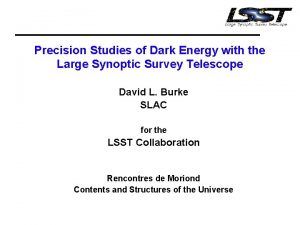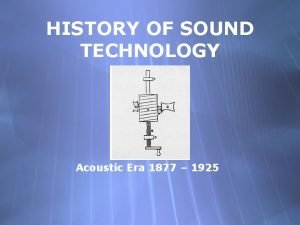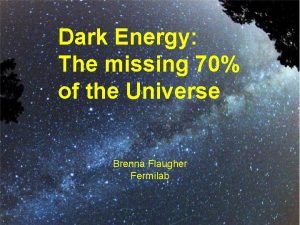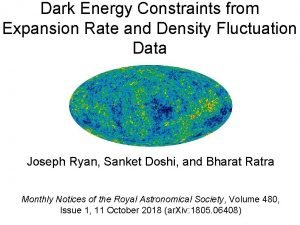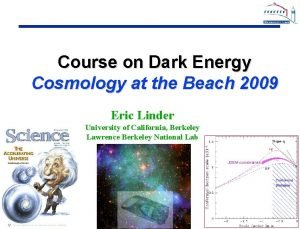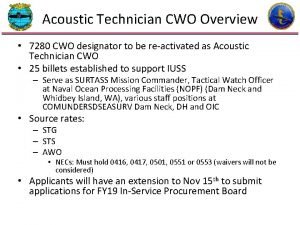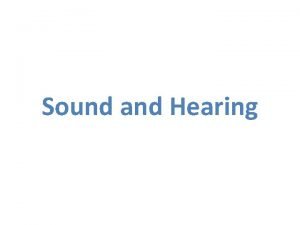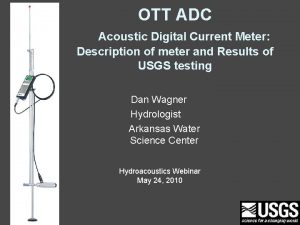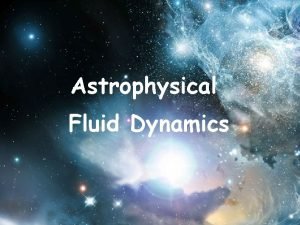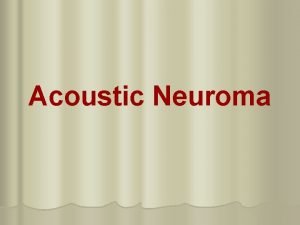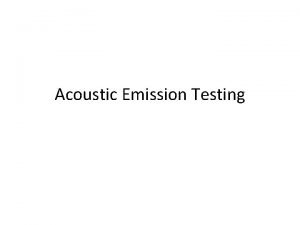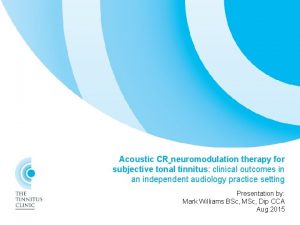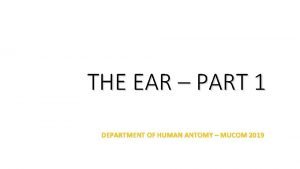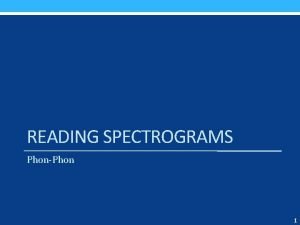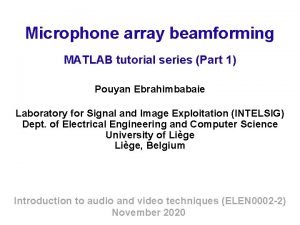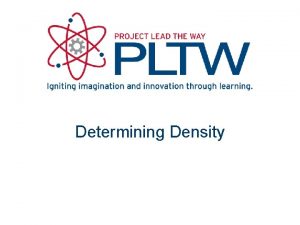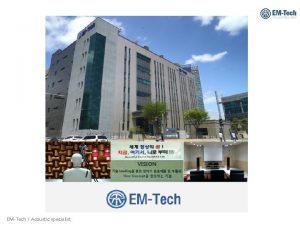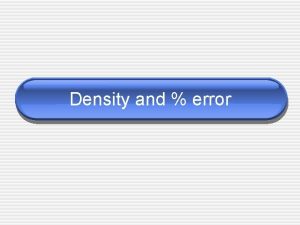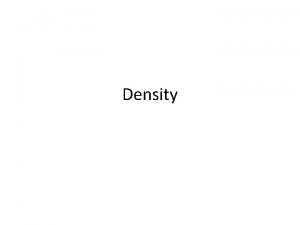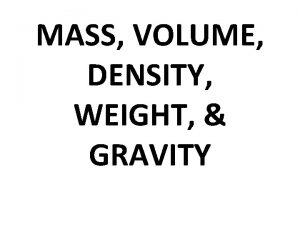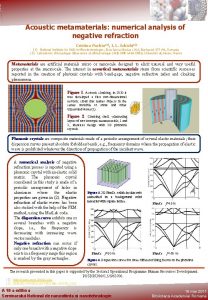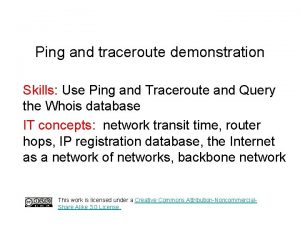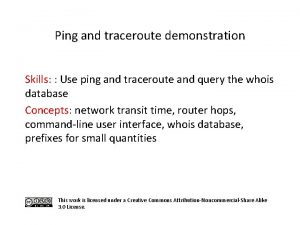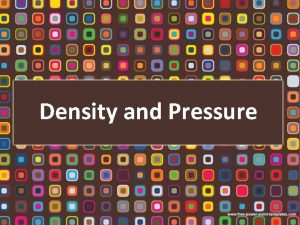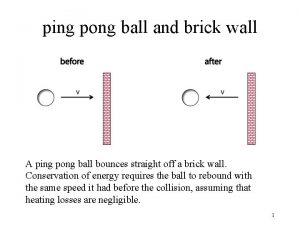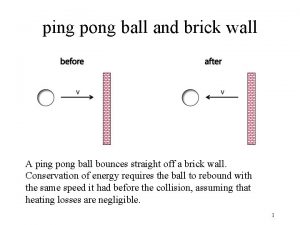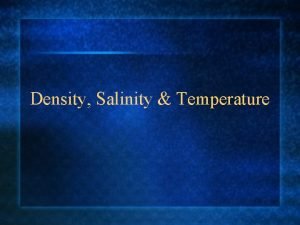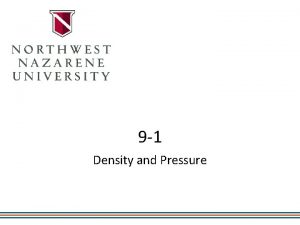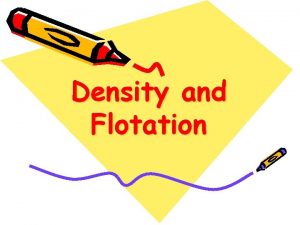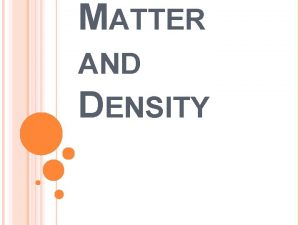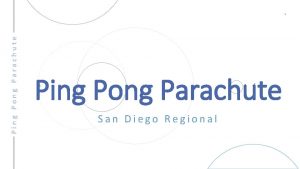Acoustic Metamaterials and the Dynamic Mass Density Ping


































- Slides: 34

Acoustic Metamaterials and the Dynamic Mass Density Ping Sheng Department of Physics, HKUST IPAM Workshop on Metamaterials 2010 -1 -25

Collaborators ¡ Jason Yang, Weijia Wen, CT Chan ¡ Zhengyou Liu ¡ Jun Mei, Min Yang

Acoustic Metamaterials ¡ ¡ For electromagnetic metamaterials, negative index of refraction can be realized when both and are negative If there are corresponding acoustic metamaterials, then both the elastic modulus B and mass density D should be negative

Static and Dynamic Mass Densities ¡ Static mass density: can be obtained by weighing the sample and its components, and determining their respective volumes Dynamic mass density: used to calculate wave speed; , in the long wavelength limit. ¡ • ¡ A even more general definition: Is there an equivalence principle, i. e. , ? .

Dynamic Mass of a Composite ¡ ¡ ¡ Different components in a composite need not move in unison — they can move relative to each other. When there are local resonances, average force and average acceleration can be out of phase - That means the dynamic mass can be negative. For wave motion, an imaginary implies an exponentially decaying wave.

Realization of Acoustic Metamaterial with Negative Dynamic Mass Locally Resonant Sonic Materials Science 289, 1734 (2000)

Special Characteristics of the Locally Resonant Sonic Materials ¡ Very subwavelength — the wavelength at the gap frequency is a few hundred times larger than the lattice constant. ¡ Do not need periodicity — same effect with random geometry. ¡ Can be very effective in attenuating low frequency sound — can break the mass density law.

Mass Density Law ¡ A normal incident sound wave passing through a slab of homogeneous solid with thickness d and mass densityρ. ¡ Amplitude transmission coefficient: Low frequency sound can be very penetrating!!!

Subwavelength Attenuation of Low Frequency Sound • A disadvantage — the effective frequency is not broad-band

Two Questions ¡ Can there be a membrane-type locally resonant sonic material? • ¡ Would enable stacking to broaden the attenuation bandwidth. Is each resonance always associated with the negative mass density phenomenon?

Membrane-Type Locally Resonant Sonic Materials ¡ Can we break mass density law at low frequencies by using membranes? ¡ A seeming contradiction, because total reflection requires the reflecting surface be a node, but a membrane can’t be a node, since it is so soft! ¡ But we shall see that precisely because the membrane is soft, total reflection of low frequency sound is possible.

Membrane Reflector: Samples and Measurement Epoxy Sample 2. 0 cm Rubber Membrane Structure of Sample

Frequency First Membrane Eigenmode Second Membrane Eigenmode Layer Membrane Eigenstates

Frequency Between the two eigen-frequencies, we have the superposition of the two eigen modes Layer Superposition of Eigenstates What is special at that frequency is that the average normal displacement of the membrane, , is zero. Vibration mode at the frequency of minimum transmission. So what is the physics?

Propagation Mode in Air d For the , we have , hence => non-propagating evanescent wave in the far field. For , we have and hence . Therefore far field transmission is only proportional to . Conclusion: if , then we only have No far field transmission!

Laser Vibrometer Laser Beam Vibrometer Vibrating Surface Doppler shift of reflected light determines velocity

Source Detectors Detector Sample Transmission minimum when the areal average displacement is zero

Near-Total Reflection State Velocity Distribution at the Reflection Frequency

Dynamic Effective Mass can be Negative , At the reflection frequency

Comparison with Experimental Results Theoretical Results Reference: PRL 101, 204301 (2008).

Acoustic Metamaterials also Imply New Addition Rule Mass Density Law: Doubling the wall thickness: Increase in STL 18 d. B would require 8 times the wall thickness! Acoustic Metamaterials: Exponential decay:

• Max. TL = 48. d. B at 200 Hz • Weight = 4 kg/m 2, (~ 2 mm thick glass plate) • As Effective as an 8 -layer brick wall


Light Weight Broadband Shield from 50 to 1500 Hz Thickness 60 mm and Weigh 15 kg/m 2 Average Transmission Loss = 45. 1 d. B 30 cm

Mass Density in the Limit of Zero Frequency ¡ For a time-harmonic wave, the elastic wave equation may be written as ¡ Effective moduli and mass density are usually defined at the long-wavelength limit, hence the limit is usually taken first. Mass density disappears from the consideration. ¡ Effective moduli are obtained by homogenization of the operators.

Exception for the Fluid-Solid Composites ¡ Volume-averaged value, , is correct only when the components move uniformly in the limit. ¡ For invicid fluid, relative motion between fluid and solid is possible — breakdown of the validity for . ¡ A new formalism is desired when viscosity . ¡ Physically, the new regime corresponds to the situation when the fluid channel width the viscous boundary layer thickness .

Obtaining the Effective Mass Density Expression ¡ Have to start from the wave equation ¡ Obtain the low-frequency wave solution and the dispersion relation . From the low frequency slope of , one can obtain the p-wave velocity. ¡ But the p-wave velocity contains both the bulk modulus and mass density information. l Need additional criterion to separate out the information — different angular channels.

Using Multiple Scattering Theory to Derive the Mass Density Expression Schematic diagram of the multiple scattering theory (MST) ¡ MST represents a solution approach to the elastic equation for a periodic composite that l accounts fully for all the multiple scattering effects between any two scatterers, and l accounts for the inherent vector character of the elastic waves

Long Wavelength Limit of MST ¡ At long wavelength the composite is an effective medium, with an effective wave speed. l ¡ vs. k is in the linear regime What is the effective medium described by MST?

Dynamic Effective Mass Density ¡ Resulting expression for the effective mass density Deff : l Same as the expression derived by J. Berryman in 1980. l However, there was no experimental support. l Also the derivation, based on average T-matrix approach, was not rigorous.

Experimental Results on Fluid-Solid Composite F. Cervera et. al. , Phys. Rev. Lett. 88, 023902 (2002) ¡ ¡ (Wood’s formula) Almost perfect agreement is obtained by using the Deff instead of DV Reference: Mei, Liu, Wen and Sheng, Phys. Rev. Lett. 96, 024301 -024304 (2006)

Concluding Remarks ¡ Effective dynamic mass density of an inhomogeneous mixture can not only differ from its static counterpart, but also be negative at finite frequencies. ¡ Thin membranes can reflect low frequency sound! ¡ Realization of negative dynamic mass density is associated with the “pseudo-resonance” phenomenon that requires at least two eigenmodes of the system.

References ¡ Z. Liu, X. X. Zhang, Y. Mao, Y. Y. Zhu, Z. Yang, C. T. Chan and P. Sheng, Science 289, 1734 (2000). ¡ Z. Liu, C. T. Chan and P. Sheng, Phys. Rev. B 71, 014103 (2005). ¡ J. Mei, Z. Liu, W. Wen and P. Sheng, Phys. Rev. Lett. 96, 024301 (2006). ¡ P. Sheng, J. Mei, Z. Liu and W. Wen, Physica B 394, 256 (2007). ¡ J. Mei, Z. Liu, W. Wen and P. Sheng, Phys. Rev. B 76, 134205 (2007). ¡ Z. Yang, J. Mei, M. Yang, N. H. Chan and Ping Sheng, Phys. Rev. Lett, 101, 204301 (2008).

~ Thank you ~
 Site:slidetodoc.com
Site:slidetodoc.com Planar density units
Planar density units Linear density of fcc 110
Linear density of fcc 110 Physiological density
Physiological density High density low density
High density low density Countries with high physiological density
Countries with high physiological density Mass density volume questions
Mass density volume questions How to find volume density and mass
How to find volume density and mass Mass m, volume v and density d are correlated as
Mass m, volume v and density d are correlated as What liquid is less dense than water
What liquid is less dense than water Mass volume density triangle
Mass volume density triangle Brain pop density
Brain pop density Mass and volume to density
Mass and volume to density Formula for density mass and volume
Formula for density mass and volume Density mass volume
Density mass volume Optical vs acoustic phonons
Optical vs acoustic phonons What is the function of the external acoustic meatus
What is the function of the external acoustic meatus Acoustic characteristics of american english vowels
Acoustic characteristics of american english vowels Baryon acoustic oscillations
Baryon acoustic oscillations Acoustic era of recording technology
Acoustic era of recording technology The expanding faster than should
The expanding faster than should Baryon acoustic oscillations
Baryon acoustic oscillations Baryon acoustic oscillations
Baryon acoustic oscillations Acoustic technician
Acoustic technician Acoustic stimulus is
Acoustic stimulus is Ott current meter
Ott current meter Lecture hall acoustics
Lecture hall acoustics Baryonic acoustic oscillations
Baryonic acoustic oscillations Rollover phenomenon in acoustic neuroma
Rollover phenomenon in acoustic neuroma Acoustic emission testing applications
Acoustic emission testing applications Acoustic cr
Acoustic cr Ear antomy
Ear antomy Mesenchyme cells
Mesenchyme cells Reading spectrograms
Reading spectrograms Microphone array beamforming tutorial
Microphone array beamforming tutorial







